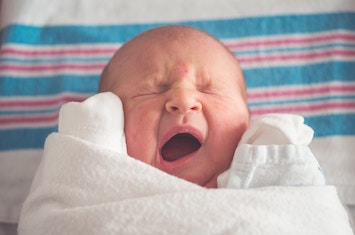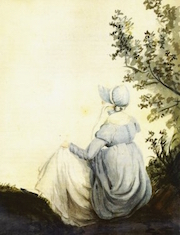
Pronouns provide a quick, convenient way to refer to an earlier noun without repeating it (as it does in this sentence). But there is one problem: what pronoun can we use for a single person when we don’t know the person’s sex, given that pronouns indicate sex? For example, consider this sentence:
The child paddles at the edge of the water to cool off on one of the last days of a hot summer.
What pronoun should be used for a second sentence to refer to the child? He? She? It? He and she are both too specific, giving us information that we may not have about the child. It may be technically correct but sounds odd; it makes the child seem like a thing rather than a person.
Sadly, in English, we have been trying to come up with a solution to this problem for at least the last forty years without success. We just do not have a gender-neutral singular personal pronoun.
Until the 1960s, the practice was that the singular male pronoun (he) ‘included’ women. The rise of second-wave feminism challenged this, highlighting how silly this convention was in sentences like this one:
Man is a mammal, which means he suckles his young.
Various solutions have been tried. In the 1980s, popular women’s magazines would use he in one paragraph and she in the next. For example:
If your baby is crying, the most likely cause is that he is hungry. His stomach is only baby-sized, after all, so you need to feed him often.
It is also possible that your baby is over-tired. Crying is one way that she can signal to you that she wants to sleep.
This approach is still used in writing about babies and childcare.

There are various other options. None of them works for every sentence or context, so you need to know them all and use whichever one is most appropriate for your writing.
- Change your sentence to plural.
- Leave the pronoun out.
- Repeat your noun.
- Use the rather cumbersome he or she or his or her (I do not recommend using he/she – see my post on the forward slash for an explanation).
- Rewrite your sentence.
Using a combination of these strategies, the previous example would become something like this:
If your baby is crying, the most likely cause is hunger [rewrite to avoid pronoun]. Babies’ stomachs [changed to plural] are only baby-sized, after all, so you need to feed your baby [repeat the noun] often.
It is also possible that your baby is over-tired. Crying is one way that a baby [repeat the noun] can signal to you that he or she [use of he or she] wants to sleep.
They

But the solution that most writers have come to use most often is to use the plural pronoun they. The use of they is still controversial, with many people (both women and men) finding the use of a plural pronoun with a singular antecedent wrong, as it breaks one of the fundamental rules about pronouns (a pronoun must agree with its antecedent in number). I’m a bit of a fence-sitter here. I’m not a huge fan of they with a singular antecedent and I have been known to opt for he or she in instances where very strict grammatical correctness is required (such as secondary school textbooks). But I will use they in other contexts. For example, I am happy with the use of they in this type of situation:
If your baby is crying, the most likely cause is that they are hungry. Their stomach is only baby-sized, after all, so you need to feed them often.
It is also possible that your baby is over-tired. Crying is one way that they can signal to you that they want to sleep.
(I’d probably be inclined to make the second sentence entirely plural – Their stomachs are . . . – but the sentence is, to me, acceptable as it is. Grappling with when you the pronoun is to be plural and when singular is the tricky part of using they as a gender-neutral singular pronoun.)
There are sound arguments for the use of they for a singular pronoun of indeterminate sex. They has been used for singular antecedents by writers as esteemed as Shakespeare and Jane Austen. (Yes, writers have been grappling with this issue for at least four hundred years.) Shakespeare seems only to have used it twice (in A Comedy of Errors and the poem ‘The Rape of Lucrece’) but if he could invent words such as assassination, bedazzle and scuffle with just a single use, two uses looks like a ringing endorsement. Jane Austen was a much more prolific user, with a number of examples to be found in each of her best-known books (and not just coming from the mouths of the more foolish characters). Some writers today are experimenting with abandoning the sex-specific singular pronouns (he and she) altogether, and using they in all cases, not just where the sex of the antecedent is unknown
In some ways, it is possible to argue the use of they for a gender-neutral singular pronoun matches our use of you and you for singular and plural second-person pronouns. And we do not have separate pronouns to indicate a group of two or more men, two or more women, and a group of both men and women: they covers all of these, so why not add third-person indeterminate singular pronoun to it uses?

‘To be sure, you knew no actual good of me – but nobody thinks of that when they fall in love.’ Elizabeth Bennett to Darcy, Pride and Prejudice

If you have found this post interesting, you can find a full index to my other posts on the index page. To be notified when I post a new topic, follow me on Facebook! If you have any particular questions you’d like me to answer in future posts, just send me a message. I’m always interested to learn what people think, and how you came across this site, so please post a comment.
If you think you would be interested in either my complete grammar course or an individual customised online course (particularly suited for people who don’t live in Melbourne), just click your preferred option.
Photos: child by Daiga Ellaby, baby by Tim Bish, legs by Ben Weber, all on Unsplash; portrait of Jane Austen by her sister Cassandra from Wikimedia Commons under the CC 0 licence (for more details of the licence, see the copyright page)
3 comments on “Pronouns: he or she? The gender-neutral problem”